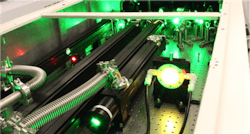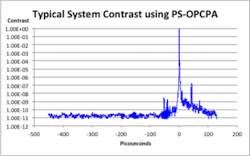National Energetics 20 TW laser completes commissioning at Tel Aviv University
National Energetics (Austin, TX) has completed the installation of a 10 Hz, 20 TW laser system at Tel Aviv University in Israel. This system is currently the most powerful laser in the Middle East.
The laser uses picosecond optical parametric chirped-pulse amplification (PS-OPCPA) for most of the system gain, followed by a traditional Ti:sapphire power amplifier. PS-OPCPA offers significant improvements to current Ti:sapphire ultrafast laser architectures, according to National Energetics. The technique amplifies the seed pulse in a picosecond window, enhancing contrast and eliminating prepulses associated with the use of classic regenerative amplifiers.
"The laser is compact, stable, and easy to use," says Ishay Pomerantz, principal investigator at the School of Physics and Astronomy of Tel Aviv University. "We needed a turnkey laser that would allow us to focus on our research into laser-driven particle acceleration rather than dedicate time to align and support a typical high energy laser system. The laser from National Energetics has delivered to our specifications, including a contrast ratio of better than 1010:1 with no measureable prepulses."PS-OPCPA is a key component for next-generation ultra-intense laser systems. With this technique, amplification of a chirped pulse by interactions in nonlinear optical crystals replaces traditional laser amplifiers in at least some of the laser chain. Proper design of the nonlinear optical interaction yields gains of 106 via a single pass through a 1-2 cm nonlinear optical crystal.
PS-OPCPA delivers exceptional intrinsic pulse contrast in the temporal range of 10 ns down to 20 ps, according to National Energetics, as well as improved contrast in the 2 to 20 ps temporal window. It is in this window (2-20 ps), much closer to the laser pulse, which is far more difficult to control and measure. Contrast in this range is largely driven by the creation of post pulses in the laser chain, which nonlinearly mix with the main pulse while they are stretched to produce prepulses upon compression. These prepulses are only present when the laser operates at full power and cannot, therefore, be measured on the system with only the front end operating.
"Our experience on lasers in our labs is that the use of a regenerative amplifier is a common culprit in producing the post-pulses, which lead to this problem," says Todd Ditmire, president of National Energetics. "We believe that PS-OPCPA is the best way to construct a CPA laser destined for plasma physics experiments, a belief born from direct experience as experimentalists who have used lasers with and without OPCPA front ends in experiments for many years."
For more info, see www.nationalenergetics.com.
Source: National Energetics
About the Author
John Wallace
Senior Technical Editor (1998-2022)
John Wallace was with Laser Focus World for nearly 25 years, retiring in late June 2022. He obtained a bachelor's degree in mechanical engineering and physics at Rutgers University and a master's in optical engineering at the University of Rochester. Before becoming an editor, John worked as an engineer at RCA, Exxon, Eastman Kodak, and GCA Corporation.


